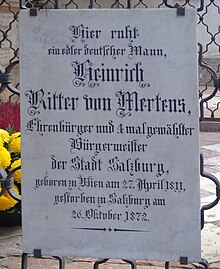Heinrich von Mertens


Heinrich Ritter von Mertens (born April 28, 1811 in Vienna , † October 26, 1872 in Salzburg ) was mayor of the city of Salzburg from 1861 to 1872 .
Mertens studied Jus at the University of Vienna and entered 1833 in the civil service, he worked for the provincial government of Lower Austria and Upper Austria. In 1848 he had to leave the civil service and Vienna because of his enthusiastic support for the freedom movement of 1848 . He settled in Salzburg. He bought Leopoldskron Castle and after reselling it to King Ludwig I , he acquired the Daunschlössl in Nonntal . Mertens came from an old Dutch noble family (one of his ancestors was mayor of Brussels in 1492 ). Although he was very wealthy through his family and also through his marriage to Anna Steinbauer, the daughter of the brewery and estate owner of the Hundsthurm lordship , he lost his fortune through property speculation . So he had to squander the Weingartenschlössl and move with his family of 10 to a rented apartment in Mirabell Palace .
From 1861 to 1871 he was a member of the Salzburg state parliament and from 1861 to 1872 he was mayor of Salzburg. It is said that he had the so-called mayor's hole (a breakthrough through the Paris-Lodron wall on the Mönchsberg in the direction of Nonntal) built in order to get from his place of residence to his official seat in the city more quickly. After his election as mayor, he introduced a number of innovations, e.g. B. the restoration of the publicity of the municipal council meetings, the rebuilding of the municipal administration or the transfer of the local police into the autonomous sphere of activity of the municipality. Mertens was loyal to the imperial family, but he passionately rejected the absolutism of the former Metternich- style police state .
During his term of office, the opening of the Salzburg railway lines and in 1866 the imperial donation of the Mirabell Castle and the fortress grounds to the city of Salzburg, which as a result and also because of the meetings between Emperor Franz Josef and Napoléon III. and Wilhelm I experienced a great boom at this time. In 1862 the meeting of the German Art Society took place, in 1863 it was the congress of the German Railway Association and in 1864 the first agricultural exhibition; Tourism also began to play a major role during his tenure.
In December 1866 he was made an honorary citizen of the city of Salzburg. In 1862 he was entrusted with the management of the " City Beautification Committee ". On October 26, 1872, he died of a brain tumor. Mertensstrasse in Elisabeth-Vorstadt is named after him . After his death he found his final resting place in the St. Peter cemetery in Salzburg (arcade crypt no. XIX).
| predecessor | Office | successor |
|---|---|---|
| Franz Xaver Späth |
Mayor of Salzburg 1861 - 1872 |
Ignaz Harrer |
literature
- Josef Gassner: Mertens Heinrich von. In: Austrian Biographical Lexicon 1815–1950 (ÖBL). Volume 6, Verlag der Österreichischen Akademie der Wissenschaften, Vienna 1975, ISBN 3-7001-0128-7 , p. 236.
Individual evidence
- ↑ Franz Schirlbauer, Franz Ruedl: Salzburg. Lasting values in good hands. 125 years of the Salzburg City Association 1862–1987 (= Bastei. Vol. 36, No. 6/7, 1987, ZDB -ID 568788-3 ). Salzburg City Association, Salzburg 1987, p. 19.
| personal data | |
|---|---|
| SURNAME | Mertens, Heinrich von |
| ALTERNATIVE NAMES | Mertens, Heinrich Ritter von (full name) |
| BRIEF DESCRIPTION | Austrian politician, member of the state parliament, mayor of Salzburg (1861–1872) |
| DATE OF BIRTH | April 28, 1811 |
| PLACE OF BIRTH | Vienna |
| DATE OF DEATH | October 26, 1872 |
| Place of death | Salzburg |
